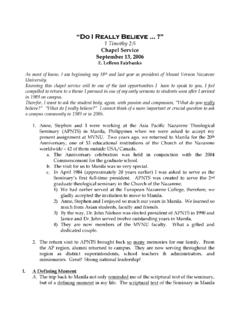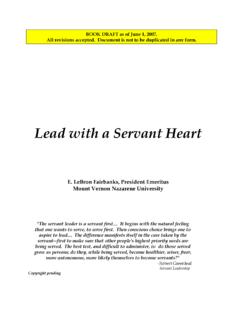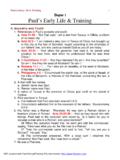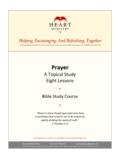Transcription of MOVING FROM VISION TO ACTION Philippians …
1 1 MOVING FROM VISION TO ACTION Philippians 1:27 World Mission Multi-Regional Conference Madrid, Spain Closing Plenary Session E. LeBron Fairbanks April 22, 2006 INTRODUCTION 1. In mentoring and teaching emerging leaders we often focus on the joy of leadership and not the pain in leadership. It is true that individuals in leadership positions have the potential to influence change and impact people. This is rewarding and we are energized. A VISION captures us. Growth and expansion will result.
2 Surely it is right. Everyone will agree! We will move ahead. The world is changed. And we are grateful! 2. We don t talk as much about the pain in leadership. This pain can be illustrated by me standing with outstretched arms. In one hand, I hold tenaciously to the VISION I believe God has given me for my assignment and responsibility. I believe it is the right ACTION to take, policy to adopt, direction to pursue or goal to adopt. 2 VISION 3. However, from the other extended arm is a hand firmly holding to reality the situation or context in which I work, the circumstances (finances/facilities) which seem to dictate what can and cannot be done, or the people or followers who must embrace the VISION if what is dreamed is to move from VISION to ACTION .
3 And we are stunned when those with whom we work reject the VISION that is cast or challenge the VISION as it is presented. The tension in holding on to our VISION and to the reality of the present situation often produces pain. / Reality of the moment VISION of the future Pain! If we relax one arm and let go of the VISION , we drift along with no direction. Reality / VISION If we hold to the VISION and let go of the people we are known as leaders without nothing happens / VISION Reality 543 It is in holding, intentionally, to both VISION and reality that the possibility exists for leaders to move from VISION to ACTION and with this intentionality comes both joy and pain for the leader.
4 4. Why? Sooner rather than later, Christian leaders are jolted when we experience this reality: good and godly people often differ on how to reach mutually desired goals; and sometimes, 6 these good and godly people COLLIDE .. and a faith community is divided, the kingdom of God suffers and satan laughs. this is the pain in leadership. Intense pain! 25. I have come to see that these collisions occur, not necessarily because of good or bad ideas, noble or sinful goals, or right or wrong solutions.
5 Rather, good and godly people most often collide over VISION and VALUES in the faith community. And we are caught in the middle of a divided group of Christians over where we should be going ( VISION ) and how we are going to get there (values). 7 6. And in the midst of these painful situations we ask ourselves, as leaders, these probing questions: 8 Is it possible, in these situations, to live and work together as Christians so that our relationships are redemptive and a witness to unbelievers of the reconciling work of God in Christ?
6 9 If in Christ, all things are made new, then how does our relationship with Christ inform and guide us in the way we lead in these painful encounters? In the midst of these conflicting situations and irreconcilable expectations placed on us, what does it mean, really mean, to lead a divided faith community with the mind of Christ? 10 These questions frame my remarks to you about leading others and MOVING a faith community from VISION to ACTION . I have pursued these questions since 1978 when I moved to a cross-cultural teaching assignment at the European Nazarene College near Schaffhausen, Switzerland.
7 Later, I probed these questions during my tenure in Manila at the Asia Pacific Nazarene Theological Seminary for the past seventeen years at Mount Vernon Nazarene University. 7. It has been through wrestling with these questions that I have learned about the leadership qualities needed to guide a faith community. And I continue to learn about the movement from a VISION of the leader to ACTION by the entire faith community, particularly in times of conflict and collision. 8. In light of these realities, I want to share with you six anchors to hold us steady as faithful Christian leaders as we grasp firmly to our VISION and, at the same time, seek to move the church, university, region or denomination to ACTION .
8 11 3 Anchor # 1: Speak Gracefully 12 Issue: Watch the words. Principle: Words we speak can bless or destroy people. What comes out of my mouth reflects what is in my heart so Jesus states in the Gospels. As leaders we either: o Encourage or discourage those with whom we work. o Uplift or put them down. 13 o Speak positively or negatively about them. o Reflect cultural sensitivity or cultural blindness to them. o Focus on the other person, or focus on self. I often ask myself: how do others feel when they leave my presence?
9 O Stronger or weaker? o Larger or smaller about themselves? 14 o Confident or scared ? o Understood or misunderstood? o Affirmed or manipulated? o Blessed or destroyed ? Henri Nouwen once stated: When the door of the steam bath is continually left open, the heat inside rapidly escapes through it. (he is referring to the problem with individuals who talk constantly.) The praise to criticism ratio with others with whom we work should be at about 80-90% praise or positive statements to 10-20% criticism or negative statements.
10 Good advice from Sven Walroos, Scandinavian clinical psychologist. 15 According to Ephesians 4:25, God uses the words we speak to others within the Body of Christ to extend His grace through us to them! What a powerful and probing thought! Remember, the words we speak to those with whom we work especially those who differ and even collide with us, can bless them or destroy them. Choose to bless them! 417 16 Anchor #1: Speak Gracefully Anchor # 2: Live Gratefully Issue: Comparison is the root of inferiority.











